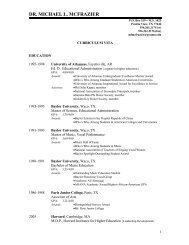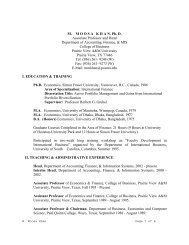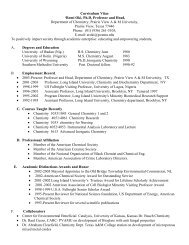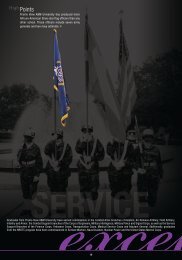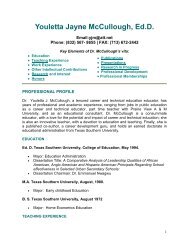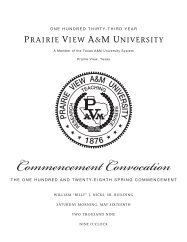Addressing Medical School Diversity Through an Undergraduate ...
Addressing Medical School Diversity Through an Undergraduate ...
Addressing Medical School Diversity Through an Undergraduate ...
Create successful ePaper yourself
Turn your PDF publications into a flip-book with our unique Google optimized e-Paper software.
<strong>Diversity</strong> Issues<br />
<strong>Addressing</strong> <strong>Medical</strong> <strong>School</strong> <strong>Diversity</strong> <strong>Through</strong><br />
<strong>an</strong> <strong>Undergraduate</strong> Partnership at Texas A&M<br />
Health Science Center: A Blueprint for Success<br />
Al<strong>an</strong> R. Parrish, PhD, Dennis E. D<strong>an</strong>iels, DrPH, R. Kelly Hester, PhD, <strong>an</strong>d<br />
Christopher C. Colenda, MPH, MD<br />
Abstract<br />
Imperative to increasing diversity in the<br />
physici<strong>an</strong> workforce is increasing the pool<br />
of qualified underrepresented minority<br />
applic<strong>an</strong>ts to medical schools. With this<br />
goal in mind, the Texas A&M Health<br />
Science Center College of Medicine (A&M<br />
College of Medicine) has partnered with<br />
Prairie View A&M University (PVAMU), a<br />
historically black college <strong>an</strong>d university<br />
that is a component of the Texas A&M<br />
university system, to develop the<br />
undergraduate medical academy (UMA).<br />
The UMA was established by legislative<br />
m<strong>an</strong>date in 2003 <strong>an</strong>d is a state-funded<br />
program. The authors describe the<br />
development of partnership between the<br />
A&M College of Medicine <strong>an</strong>d PVAMU,<br />
focusing on the key attributes that<br />
have been identified for success. The<br />
administrative structure of the UMA<br />
ensures that the presidents of the two<br />
institutions collaborate to address issues of<br />
program oversight <strong>an</strong>d facilitates a direct<br />
relationship between the de<strong>an</strong> <strong>an</strong>d<br />
associate de<strong>an</strong> for academic affairs of<br />
A&M College of Medicine <strong>an</strong>d the director<br />
of the UMA to define the program<br />
objectives <strong>an</strong>d structure. The authors<br />
delineate the admission process to<br />
the UMA, as well as the academic<br />
requirements of the program. Students<br />
attend lecture series during the academic<br />
year <strong>an</strong>d participate in summer programs<br />
on the A&M College of Medicine campus<br />
in addition to receiving intensive academic<br />
counseling <strong>an</strong>d opportunities for tutoring<br />
in several subjects. The authors also<br />
describe the initial success in medical<br />
school admissions for UMA students. This<br />
partnership provides a model blueprint<br />
that c<strong>an</strong> be adopted <strong>an</strong>d adapted by other<br />
medical schools focused on increasing<br />
diversity in medicine.<br />
Acad Med. 2008; 83:512–515.<br />
It is widely recognized that the<br />
graduating classes from our nation’s<br />
medical schools do not adequately reflect<br />
the increasing racial <strong>an</strong>d ethnic diversity<br />
in the United States. 1,2 To address this<br />
disparity, a number of programs aimed at<br />
increasing the number of qualified<br />
minority applic<strong>an</strong>ts to medical school<br />
have been established, r<strong>an</strong>ging from<br />
health science pipeline programs for high<br />
school students, 3 postbaccalaureate<br />
training, 4 <strong>an</strong>d combined BS/MD<br />
programs. 5 In the fall of 2006, the<br />
Association of Americ<strong>an</strong> <strong>Medical</strong><br />
Colleges (AAMC) launched the<br />
Dr. Parrish is associate professor, College of<br />
Medicine, Texas A&M Health Science Center,<br />
College Station, Texas.<br />
Dr. D<strong>an</strong>iels is director, <strong>Undergraduate</strong> <strong>Medical</strong><br />
Academy, Prairie View A&M University, Prairie View,<br />
Texas, <strong>an</strong>d professor, College of Medicine, Texas<br />
A&M Health Science Center, College Station, Texas.<br />
Dr. Hester is associate de<strong>an</strong> for academic affairs,<br />
College of Medicine, Texas A&M Health Science<br />
Center, College Station, Texas.<br />
Dr. Colenda is de<strong>an</strong>, College of Medicine, Texas<br />
A&M Health Science Center, College Station, Texas.<br />
Correspondence should be addressed to Dr.<br />
Colenda, Office of the De<strong>an</strong>, College of Medicine,<br />
Texas A&M Health Science Center, College Station,<br />
TX 77843-1114; telephone: (979) 845-3431; fax:<br />
(979) 847-8663; e-mail: (colenda@medicine.<br />
tamhsc.edu).<br />
AspiringDocs campaign, a nationwide<br />
program focused on increasing diversity<br />
in medical school classes that targets<br />
minority students at the undergraduate<br />
level, primarily through their Web site<br />
<strong>an</strong>d on-campus outreach efforts. 6 With<br />
the goal of increasing the pool of<br />
qualified minority medical school<br />
applic<strong>an</strong>ts in Texas, the Texas A&M<br />
Health Science Center College of<br />
Medicine (A&M College of Medicine)<br />
has partnered with Prairie View A&M<br />
University (PVAMU), a historically black<br />
college <strong>an</strong>d university (HBCU) that is a<br />
component of the Texas A&M university<br />
system, to develop the undergraduate<br />
medical academy (UMA). The UMA was<br />
designed in 2004 to cultivate a campusto-campus<br />
relationship between A&M<br />
College of Medicine faculty <strong>an</strong>d students<br />
<strong>an</strong>d PVAMU UMA students that is<br />
focused on academic enh<strong>an</strong>cement,<br />
including MCAT preparation, <strong>an</strong>d<br />
professional development. The program<br />
also provides students <strong>an</strong> introduction to<br />
clinical experiences.<br />
Developing the Partnership<br />
The Texas Legislature established the<br />
UMA in 2003 by House Bill 85. 7 The bill<br />
states that “purpose of the academy is to<br />
prepare students for medical school” by<br />
providing<br />
1) academic <strong>an</strong>d career counseling for<br />
academy students; 2) faculty mentorship<br />
for each academy student; 3) enriched<br />
undergraduate courses with the specific<br />
intent to strengthen academic preparation<br />
for future medical school applic<strong>an</strong>ts; 4)<br />
long dist<strong>an</strong>ce educational technology to<br />
allow interactive participation with<br />
medical schools, as appropriate; 5)<br />
visitation to medical school educational<br />
sites; 6) visitation of medical school<br />
faculty to the academy for academic<br />
enrichment purposes. 7<br />
Once the partnership had been<br />
established, the first step toward making<br />
it operational was to hire a UMA<br />
director. A joint search committee of<br />
A&M College of Medicine <strong>an</strong>d PVAMU<br />
faculty was involved in filling the position<br />
in the spring of 2004. Once a director<br />
had been appointed, stakeholders in the<br />
partnership worked to establish <strong>an</strong><br />
org<strong>an</strong>izational structure defining the<br />
interactions between the A&M College of<br />
Medicine <strong>an</strong>d the UMA. This structure<br />
ensures that the presidents of the two<br />
institutions collaborate to address issues<br />
of program oversight <strong>an</strong>d facilitates a<br />
direct relationship between the de<strong>an</strong><br />
<strong>an</strong>d associate de<strong>an</strong> for academic affairs<br />
of A&M College of Medicine <strong>an</strong>d the<br />
512<br />
Academic Medicine, Vol. 83, No. 5 / May 2008
<strong>Diversity</strong> Issues<br />
Prairie View A&M<br />
Texas A&M System<br />
External Advisory Board<br />
<strong>Undergraduate</strong> <strong>Medical</strong> Academy<br />
Texas A&M HSC<br />
College of Medicine<br />
school <strong>an</strong>d provides additional role<br />
models of success for them. Although this<br />
informal role modeling is a seemingly<br />
insignific<strong>an</strong>t contribution, we have<br />
identified positive reinforcement as a key<br />
component for success. In fact, during<br />
the fall 2007 EAB meeting, members<br />
suggested that they would value increased<br />
time to meet with the students.<br />
Therefore, we are currently examining<br />
the feasibility of extending the<br />
semi<strong>an</strong>nual EAB meetings to increase the<br />
contact time between UMA students <strong>an</strong>d<br />
EAB members.<br />
director of the UMA to define the<br />
program objectives <strong>an</strong>d structure (Figure<br />
1). With the org<strong>an</strong>izational structure in<br />
place, program leaders developed specific<br />
goals for the UMA:<br />
1. Identify <strong>an</strong>d attract qualified students<br />
to the UMA.<br />
2. Prepare students for entr<strong>an</strong>ce into<br />
medical school.<br />
3. Develop a nurturing mentor network.<br />
4. Identify <strong>an</strong>d develop opportunities to<br />
participate in research activities.<br />
5. Develop a nationally recognized<br />
model for this program.<br />
To track the success of the program,<br />
program leaders identified the following<br />
measurable outcomes: (1) retention <strong>an</strong>d<br />
graduation rates, (2) cumulative <strong>an</strong>d<br />
science GPA, <strong>an</strong>d (3) accept<strong>an</strong>ce rate to<br />
medical school.<br />
The funding for the UMA remains<br />
identified as special-item funding from<br />
the state of Texas. The funds are now<br />
identified by the state as Academic<br />
Development Initiative funds. For<br />
summer programs, special seminars,<br />
faculty development activities, <strong>an</strong>d<br />
college of medicine faculty time <strong>an</strong>d<br />
effort, the de<strong>an</strong> of the college of medicine<br />
continues to fund these activities through<br />
Director<br />
Academic<br />
Advising<br />
Students<br />
Administration:<br />
Goals & Objectives<br />
Admissions<br />
Seminar<br />
Academic Enh<strong>an</strong>cement<br />
Mentoring<br />
De<strong>an</strong><br />
Associate De<strong>an</strong><br />
Faculty<br />
Students<br />
Figure 1 A visual representation of the org<strong>an</strong>izational structure of the <strong>Undergraduate</strong> <strong>Medical</strong><br />
Academy, a partnership established in 2003, between Texas A&M College of Medicine <strong>an</strong>d Prairie<br />
View A&M University.<br />
collegiate revenue sources. The value of<br />
the partnership <strong>an</strong>d the program more<br />
th<strong>an</strong> justifies the expenditures. Ongoing<br />
efforts to find external support from<br />
foundations <strong>an</strong>d other funding agencies<br />
continue as opportunities arise.<br />
An external advisory board (EAB) was also<br />
formed to provide feedback on program<br />
development. The EAB consists of 13<br />
physici<strong>an</strong>s <strong>an</strong>d university administrators<br />
interested in the overall goal of increasing<br />
diversity in the physici<strong>an</strong> workforce. EAB<br />
members are upper-level administrators of<br />
academic, governmental, or private health<br />
care units. The EAB meets twice a year,<br />
<strong>an</strong>d the members offer recommendations<br />
on a number of topics including student<br />
recruitment, program development, <strong>an</strong>d<br />
funding opportunities, <strong>an</strong>d also provide<br />
insight into other programs across the<br />
country that are committed to similar<br />
goals. The UMA director <strong>an</strong>d the A&M<br />
College of Medicine de<strong>an</strong> <strong>an</strong>d associate<br />
de<strong>an</strong> for academic affairs evaluate EAB<br />
recommendations before they are<br />
implemented. Members of the EAB also<br />
interact with UMA students during one<br />
of their visits to PVAMU each year. UMA<br />
students give EAB members a tour of the<br />
campus <strong>an</strong>d meet with them over meals.<br />
This informal interaction reinforces the<br />
students’ desires to pursue medical<br />
Admissions<br />
Shortly after the UMA director was hired,<br />
the first class of the UMA was selected in<br />
the fall of 2004 by a combination of A&M<br />
College of Medicine <strong>an</strong>d UMA faculty<br />
<strong>an</strong>d staff. There is equal representation<br />
from the UMA staff <strong>an</strong>d A&M College<br />
of Medicine on the UMA admissions<br />
committee. The pool of eligible c<strong>an</strong>didates<br />
(100–150) consists of students coded as<br />
premed by the office of the registrar on<br />
admission to PVAMU. These individuals<br />
are screened by UMA staff for eligibility<br />
based on GPA <strong>an</strong>d are then contacted by<br />
mail <strong>an</strong>d e-mail with <strong>an</strong> introduction to the<br />
UMA. At this point, approximately 40 to 45<br />
students are invited to apply to the UMA,<br />
<strong>an</strong>d 30 students are interviewed. Admission<br />
to the UMA is based on the applic<strong>an</strong>t’s<br />
academic perform<strong>an</strong>ce at PVAMU (a<br />
minimum GPA of 3.25 is required for<br />
admission <strong>an</strong>d must be maintained to<br />
remain in good st<strong>an</strong>ding), a personal<br />
statement detailing the applic<strong>an</strong>t’s<br />
motivation for a career in medicine, letters<br />
of recommendation, <strong>an</strong>d <strong>an</strong> interview. In<br />
the first three years of the UMA, the class<br />
sizes have been 18, 15, <strong>an</strong>d 23 students.<br />
A&M College of Medicine’s involvement<br />
in the admissions process is a key feature<br />
of the program. This strategy allows for<br />
<strong>an</strong> immediate interaction between the<br />
A&M College of Medicine <strong>an</strong>d PVAMU<br />
UMA faculty <strong>an</strong>d students. The involvement<br />
of A&M College of Medicine faculty<br />
from the beginning ensures their deep<br />
investment in the students’ progress <strong>an</strong>d<br />
success. The joint admissions strategy also<br />
provides the students with import<strong>an</strong>t<br />
insight into the interview process that will<br />
be involved in their applications to medical<br />
school. In fact, several members of the<br />
A&M College of Medicine medical<br />
admissions committee participate in the<br />
UMA admissions process. In previous<br />
Academic Medicine, Vol. 83, No. 5 / May 2008 513
<strong>Diversity</strong> Issues<br />
years, interviews/admissions have been<br />
conducted in the spring semester of the<br />
applic<strong>an</strong>ts’ freshm<strong>an</strong> year. Entering the<br />
program early in their undergraduate<br />
careers allows the students additional<br />
time in the program to enh<strong>an</strong>ce their<br />
academic preparation, specifically for the<br />
MCAT.<br />
Academics<br />
In the first three years of the program, 56<br />
students have been admitted to the UMA.<br />
At this point, UMA students pursue their<br />
declared undergraduate major; there is<br />
no st<strong>an</strong>dardized UMA curriculum that is<br />
required. However, as the number of<br />
UMA faculty increases, we expect to offer<br />
honors sections in several chemistry <strong>an</strong>d<br />
biology courses to UMA students. After<br />
students are admitted at the end of their<br />
freshm<strong>an</strong> year, the program involves<br />
intensive academic counseling for<br />
the students, as well as a number of<br />
opportunities for tutoring in several<br />
subjects. The initial class of students<br />
beg<strong>an</strong> learning skills seminars <strong>an</strong>d MCAT<br />
preparatory classes immediately to<br />
address the UMA goal of improving<br />
academic preparation for medical school<br />
admissions. Initially, we provided one<br />
semester of MCAT preparation for each<br />
student through a commercial vendor.<br />
However, on the basis of student<br />
feedback <strong>an</strong>d MCAT scores from the<br />
initial class, MCAT preparation has now<br />
been extended to a year-round activity.<br />
Seminar series<br />
After the first class of students was<br />
admitted in the fall of 2004, a biweekly<br />
UMA seminar series beg<strong>an</strong> on the<br />
PVAMU campus. These seminars feature<br />
A&M College of Medicine faculty <strong>an</strong>d<br />
students <strong>an</strong>d are designed to introduce<br />
the UMA students to key concepts in<br />
basic <strong>an</strong>d clinical science <strong>an</strong>d to expose<br />
them to various clinical specialties.<br />
Additionally, the seminars provide<br />
the students unique insights into the<br />
challenges <strong>an</strong>d rewards of a career in<br />
medicine. Because they may conflict with<br />
students’ class schedules, these sessions<br />
are not m<strong>an</strong>datory; however, they are<br />
well attended (more th<strong>an</strong> 50% of<br />
students attend each session).<br />
In the first three years, more th<strong>an</strong> 20<br />
A&M College of Medicine faculty<br />
members have traveled to PVAMU to<br />
present to the students. The majority of<br />
the seminars from the basic scientists<br />
focus on research issues, though others<br />
are modified first- <strong>an</strong>d second-year<br />
medical school lectures. Clinici<strong>an</strong><br />
lecturers give a background of their<br />
specialty, but they usually focus on<br />
their personal stories of how they got<br />
to their current positions.<br />
The most import<strong>an</strong>t component of the<br />
seminar series, however, may be the visits<br />
by A&M College of Medicine medical<br />
students. These sessions, which are<br />
scheduled once per semester, have<br />
proven to be highly successful. The UMA<br />
students are highly interactive, <strong>an</strong>d the<br />
opportunity to learn from their peers<br />
about a number of topics—learning<br />
skills, MCAT preparation strategies,<br />
medical school admission process—is<br />
irreplaceable. Again, the positive<br />
reinforcement for the students of seeing<br />
success stories is one of the most<br />
import<strong>an</strong>t components of the program.<br />
These sessions have also proven to be a<br />
positive experience for the A&M College<br />
of Medicine students; they have taken<br />
to this mentorship role in a vigorous<br />
m<strong>an</strong>ner. In fact, the A&M College of<br />
Medicine chapter of the Student National<br />
<strong>Medical</strong> Association (SNMA) has established<br />
extensive bonds with the UMA students.<br />
They have hosted students at the regional<br />
SNMA conference <strong>an</strong>d traveled together to<br />
the national conference, <strong>an</strong>d they visit the<br />
campus multiple times during the academic<br />
year. In addition to these interactions,<br />
the A&M College of Medicine hosts the<br />
students once a year. This allows the<br />
students to tour the facilities <strong>an</strong>d to meet<br />
additional faculty <strong>an</strong>d students.<br />
Summer program<br />
A summer program for UMA students<br />
beg<strong>an</strong> at the A&M College of Medicine<br />
in the summer of 2005 with members of<br />
the initial class of UMA students. This<br />
summer program is not m<strong>an</strong>datory,<br />
because some UMA students participate<br />
in summer programs at other medical<br />
schools or take classes during summer<br />
school. During the six-week program,<br />
students are exposed to biomedical research<br />
by working in one of several research<br />
laboratories for 30 hours per week.<br />
We attempt to place each student in a<br />
laboratory devoted to his or her identified<br />
area of interest (e.g., neuroscience,<br />
cardiovascular disease, molecular biology).<br />
At the end of the program, students present<br />
their work in a poster session attended by<br />
A&M College of Medicine faculty <strong>an</strong>d<br />
students.<br />
During this summer experience, students<br />
also participate in a preceptorship<br />
program one afternoon per week to<br />
increase their exposure to clinical<br />
medicine. During this part of the<br />
program, students shadow clinici<strong>an</strong>s<br />
(one-to-one ratio) in a variety of<br />
specialties. Students shadow a different<br />
physici<strong>an</strong> each week in <strong>an</strong> attempt to<br />
expose each student to clinical medicine<br />
as broadly as possible. This component<br />
of the program was highly regarded by<br />
the initial students, <strong>an</strong>d in subsequent<br />
summers the preceptorship program<br />
has been exp<strong>an</strong>ded from one to two<br />
afternoons per week. In 2006, the program<br />
was extended from six to eight weeks on the<br />
basis of feedback from faculty that the extra<br />
time would increase the students’ research<br />
exposure. However, this decision had<br />
unintended consequences—a six-week<br />
program allows the students to finish their<br />
UMA summer experience <strong>an</strong>d still take<br />
classes during the second summer session,<br />
whereas <strong>an</strong> eight-week program does not<br />
allow students this opportunity. Realizing<br />
that this may hinder certain students,<br />
the current <strong>an</strong>d future summer programs<br />
will be a six-week experience. The summer<br />
experience for the UMA runs simult<strong>an</strong>eously<br />
with several other state <strong>an</strong>d A&M College<br />
of Medicine undergraduate programs on<br />
campus. This is <strong>an</strong> import<strong>an</strong>t strength of<br />
the summer experience, as UMA students<br />
<strong>an</strong>d students from m<strong>an</strong>y other universities<br />
in Texas live <strong>an</strong>d work together for the<br />
summer. These students, who come from<br />
diverse backgrounds but share the same<br />
ambitions, have the opportunity to come<br />
together in their pursuit of a common goal,<br />
learning from each other along the way.<br />
Beginning in the summer of 2007, a<br />
major modification was made to the<br />
summer program. In the first four years<br />
of the program, it became clear that the<br />
MCAT remains the major obstacle for<br />
most, if not all, of the UMA students.<br />
Therefore, the emphasis in the summer<br />
program has been shifted from a<br />
biomedical research/preceptorship to <strong>an</strong><br />
academic enh<strong>an</strong>cement/preceptorship<br />
approach. The students spend mornings<br />
focusing on org<strong>an</strong>ic chemistry <strong>an</strong>d <strong>an</strong><br />
integrated histology/physiology course<br />
<strong>an</strong>d afternoons in <strong>an</strong> MCAT preparation<br />
module (three days per week) or on their<br />
clinical rotations (two days per week).<br />
Although we considered exposure to<br />
biomedical research a valuable experience,<br />
our focus must remain on ensuring that<br />
the students have the necessary academic<br />
514<br />
Academic Medicine, Vol. 83, No. 5 / May 2008
<strong>Diversity</strong> Issues<br />
background to ensure that they are<br />
competitive medical school applic<strong>an</strong>ts<br />
<strong>an</strong>d that they successfully complete the<br />
basic sciences curriculum in medical<br />
school.<br />
Lessons Learned <strong>an</strong>d Future<br />
Challenges<br />
The UMA’s overall retention rate has<br />
been 91.7%, with students leaving the<br />
program for numerous reasons,<br />
including ch<strong>an</strong>ges in career goals <strong>an</strong>d<br />
failure to meet the GPA requirements.<br />
The first class of UMA students<br />
graduated in May 2007, with a successful<br />
medical school accept<strong>an</strong>ce rate of 64%<br />
(7 of 11 students) compared with<br />
accept<strong>an</strong>ce rates of 24% (personal<br />
communication, Mr. Filomeno G.<br />
Maldonado, Assist<strong>an</strong>t De<strong>an</strong> for<br />
Admissions A&M College of Medicine,<br />
May 2007) <strong>an</strong>d 38% 8 for Afric<strong>an</strong><br />
Americ<strong>an</strong> students in Texas <strong>an</strong>d<br />
nationwide, respectively, in the same<br />
year. In addition, this percentage is<br />
higher th<strong>an</strong> the overall medical school<br />
applic<strong>an</strong>t accept<strong>an</strong>ce rate of 45%. 9<br />
This program is clearly in its inf<strong>an</strong>cy <strong>an</strong>d<br />
remains a work in progress. However,<br />
there are several strategies we have<br />
identified that c<strong>an</strong> be applied to<br />
partnerships between other medical<br />
schools <strong>an</strong>d minority undergraduate<br />
institutions. We find that the most<br />
critical feature is a geographical<br />
proximity between the two campuses that<br />
allows for personal interactions between<br />
faculty <strong>an</strong>d students. Although the<br />
AAMC AspiringDocs campaign identifies<br />
dist<strong>an</strong>ce education as a key component,<br />
in our experience the import<strong>an</strong>ce of a<br />
physical presence of the medical school<br />
faculty, students, <strong>an</strong>d staff on the<br />
undergraduate campus c<strong>an</strong>not be<br />
overstated. Our joint admissions process,<br />
which involves faculty <strong>an</strong>d staff from the<br />
UMA <strong>an</strong>d the A&M College of Medicine,<br />
places both partners in <strong>an</strong> “ownership”<br />
position; this establishes <strong>an</strong> immediate<br />
commitment for student success by both<br />
the medical school <strong>an</strong>d the undergraduate<br />
institution. Our experience is consistent<br />
with previous reports suggesting that<br />
positive factors influencing the medical<br />
school accept<strong>an</strong>ce rate for students at<br />
HBCUs include a strong affiliation<br />
between the school <strong>an</strong>d a medical<br />
school. 10 At this point, a class size of 20 to<br />
25 has been <strong>an</strong> optimal number to<br />
provide personalized academic support<br />
<strong>an</strong>d effective faculty-to-student ratios.<br />
This number is based on available space<br />
(rooms to facilitate small-group<br />
tutoring), the staff-to-student ratio for<br />
academic counseling, <strong>an</strong>d funding to<br />
support student scholarships. Finally,<br />
providing <strong>an</strong> opportunity for medical<br />
students to interact with the undergraduate<br />
students has been a key component<br />
in our success; the role of student<br />
mentorship is of utmost import<strong>an</strong>ce.<br />
We have made a promising start toward<br />
achieving our goal of better preparing<br />
minority students for the challenges of<br />
medical school, but we continue to face<br />
challenges along the way, including<br />
identifying <strong>an</strong>d securing additional<br />
funding for the summer program <strong>an</strong>d<br />
optimizing strategies that will improve<br />
student perform<strong>an</strong>ce on the MCAT.<br />
Although work remains, the goal of<br />
increasing diversity in our medical<br />
schools <strong>an</strong>d, ultimately, in the physici<strong>an</strong><br />
workforce, dem<strong>an</strong>ds our attention <strong>an</strong>d<br />
the continued development of innovative<br />
programs to meet the challenge.<br />
Acknowledgments<br />
The authors wish to acknowledge gr<strong>an</strong>t support<br />
from the Texas Higher Education Coordinating<br />
Board.<br />
References<br />
1 Cohen JJ, Gabriel BA, Terrell C. The case for<br />
diversity in the health care workforce. Health<br />
Aff (Millwood). 2002;21:90–102.<br />
2 Cohen JJ. Increasing diversity in the medical<br />
workforce is one solid way to prevent disparities<br />
in health care. MedGen Med. 2005;7:26.<br />
3 Fincher RM, Sykes-Brown W, Allen-Noble R.<br />
Health science learning academy: A successful<br />
“pipeline” educational program for high<br />
school students. Acad Med. 2002;77:737–738.<br />
4 Grumbach K, Chen E. Effectiveness of<br />
University of California postbaccalaureate<br />
premedical programs in increasing medical<br />
school matriculation for minority <strong>an</strong>d<br />
disadv<strong>an</strong>taged students. JAMA. 2006;296:<br />
1079–1085.<br />
5 Rom<strong>an</strong> SA. <strong>Addressing</strong> the urb<strong>an</strong> pipeline<br />
challenge for the physici<strong>an</strong> workforce: The<br />
Sophie Davis model. Acad Med. 2004;79:<br />
1175–1183.<br />
6 Association of Americ<strong>an</strong> <strong>Medical</strong> Colleges.<br />
Aspiring Docs.Org. Available at: (http://www.<br />
aamc.org/diversity/aspiringdocs/aspiringdocs.<br />
pdf). Accessed J<strong>an</strong>uary 28, 2007.<br />
7 Texas Legislature Online. Legislation history.<br />
Available at: (http://www.legis.state.tx.us/<br />
BillLookup/History.aspx?LegSess78R&Bill<br />
HB85). Accessed J<strong>an</strong>uary 28, 2007.<br />
8 Association of Americ<strong>an</strong> <strong>Medical</strong> Colleges.<br />
FACTS. Table 12: Applic<strong>an</strong>ts, First-Time<br />
Applic<strong>an</strong>ts, Acceptees, <strong>an</strong>d Matricul<strong>an</strong>ts to<br />
U.S. <strong>Medical</strong> <strong>School</strong>s by Hisp<strong>an</strong>ic or Latino<br />
Ethnicity, Non-Hisp<strong>an</strong>ic or Latino Race, <strong>an</strong>d<br />
Sex, 2005–2007. Available at: (http://www.<br />
aamc.org/data/facts/2007/0507sumyrs.htm).<br />
Accessed J<strong>an</strong>uary 28, 2007.<br />
9 Association of Americ<strong>an</strong> <strong>Medical</strong> Colleges.<br />
FACTS. Table 7: Applic<strong>an</strong>ts, First-Time<br />
Applic<strong>an</strong>ts, Acceptees, <strong>an</strong>d Matricul<strong>an</strong>ts to<br />
U.S. <strong>Medical</strong> <strong>School</strong>s by Sex, 1996–2007.<br />
Available at: (http://www.aamc.org/data/<br />
facts/2007/2007summary2.htm). Accessed<br />
J<strong>an</strong>uary 28, 2007.<br />
10 Atkinson DD, Spratley E, Simpson CE.<br />
Increasing the pool of qualified minority<br />
medical school applic<strong>an</strong>ts: Premedical training<br />
at historically black colleges <strong>an</strong>d universities.<br />
Public Health Rep. 1994;109:77–85.<br />
Academic Medicine, Vol. 83, No. 5 / May 2008 515


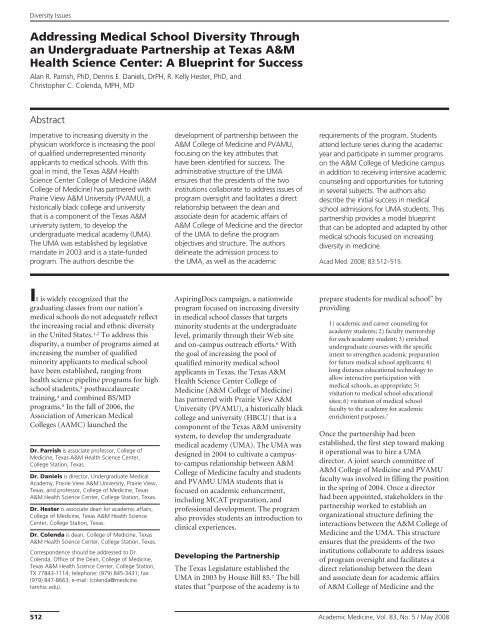
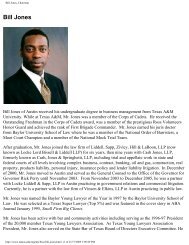
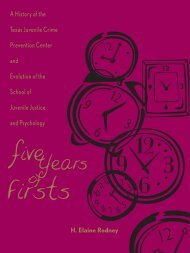
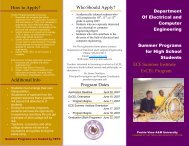
![[5a]Resume for Dr. O..](https://img.yumpu.com/42719681/1/190x245/5aresume-for-dr-o.jpg?quality=85)



